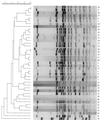Characterization of Salmonella associated with pig ear dog treats in Canada
- PMID: 11682515
- PMCID: PMC88472
- DOI: 10.1128/JCM.39.11.3962-3968.2001
Characterization of Salmonella associated with pig ear dog treats in Canada
Abstract
In the summer of 1999, the incidence of Salmonella enterica serotype Infantis infections in Alberta rose dramatically. Subsequent laboratory and epidemiological investigations established that an outbreak of human disease caused by this organism was occurring across Canada and was associated with pet treats for dogs produced from processed pig ears. Laboratory investigations using phage typing and pulsed-field gel electrophoresis (PFGE) established that isolates of Salmonella serotype Infantis from pig ear pet treats and humans exposed to pig ear pet treats comprised a well-defined subset of all isolates analyzed. Of the 53 subtypes of Salmonella serotype Infantis obtained around the time of the outbreak as defined by PFGE and phage typing, only 6 subtypes were associated with both human infection and isolation from pig ears. Together with information from epidemiological studies, these investigations established pig ear pet treats as the cause of the Salmonella serotype Infantis outbreak. The results are consistent with a model in which contaminated pig ear pet treats constitute a long-term, continuing vehicle for infection of the human population rather than causing temporally delimited point-source outbreaks. During the course of this outbreak, several other Salmonella serotypes were also isolated from pet treats, suggesting these products may be an important source of enteric infection in both humans and dogs. Though isolates of Salmonella serotypes other than Salmonella serotype Infantis from pet treats were also subjected to PFGE and phage typing, no link with human disease could be definitively established, and the contribution of pig ear pet treats to human disease remains unclear. Elimination of bacterial contamination from pet treats is required to reduce the risk of infection from these products.
Figures
References
-
- Buzby J C, Roberts T. Economic costs and trade impacts of microbial foodborne illness. World Health Stat Q. 1997;50:57–66. - PubMed
-
- Centers for Disease Control and Prevention. Standardized molecular subtyping of foodborne bacterial pathogens by pulsed-field gel electrophoresis. Atlanta, Ga: The National Molecular Subtyping Network for Foodborne Disease Surveillance. Centers for Disease Control and Prevention; 1998.
-
- Cuff W, Khakhria R, Woodward D L, Ahmed R, Clark C G, Rodgers F G. Enteric pathogens identified in Canada: annual summary 1997. Winnipeg, Manitoba, Canada: Laboratory Centre for Disease Control; 2000.
MeSH terms
LinkOut - more resources
Full Text Sources
Other Literature Sources
Medical



